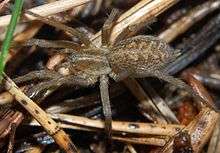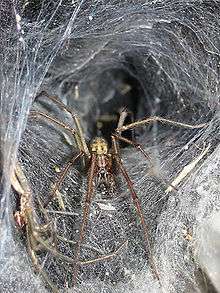Agelenidae
| Araneomorph funnel weaver Spiders | |
|---|---|
| | |
| Female Agelenopsis ("grass spider") | |
| Scientific classification | |
| Kingdom: | Animalia |
| Phylum: | Arthropoda |
| Subphylum: | Chelicerata |
| Class: | Arachnida |
| Order: | Araneae |
| Suborder: | Opisthothelae |
| Infraorder: | Araneomorphae |
| Family: | Agelenidae C. L. Koch, 1837 |
| Genera | |
|
See text. | |
| Diversity[1] | |
| 70 genera, 1168 species | |
 | |
The Agelenidae are a large family of spiders in the suborder Araneomorphae. Well-known examples include the common "grass spiders" of the genus Agelenopsis. Nearly all Agelenidae are harmless to humans, but the bite of the "hobo spider" (Eratigena agrestis) may be medically significant and there is evidence that it might cause necrotic lesions.[2] However, the matter remains subject to debate.[3] The most widely accepted common name for members of the family is "Funnel weaver".[4]
Description




The smallest species of the Agelenidae are about 4 mm in bodily length, excluding leg span. Fairly large species are about 20 mm in length. Some exceptionally large species, for example Eratigena atrica, may reach 5 cm to 10 cm in total leg span.
Agelenidae have eight eyes in two horizontal rows of four. The cephalothorax narrows somewhat towards the front where the eyes are. The abdomen is more or less oval, usually patterned with two rows of lines and spots. Some species have longitudinal lines on the dorsal surface of the cephalothorax whereas other species do not; for example, the hobo spider does not, which assists in informally distinguishing it from similar-looking species.[5]
Biology
Most of the Agelenidae are very fast runners, especially on their webs. With speeds clocked at 1.73 ft/s (0.53 m/s), the Giant house spider held the Guinness Book of World Records title for top spider speed until 1987. A recent literature review found peer-reviewed accounts of several agelenid species achieving speeds in this range, though some other taxa have achieved higher speeds.[6][7]
Agelenids build a flat sheet of non-sticky web with a funnel-shaped retreat to one side or occasionally in the middle, depending on the situation and species. Accordingly, "funnel weaver" is the most widely accepted common name for members of the family, but they should not be confused with the so-called "funnel-web tarantulas" or "funnel-web spiders" of the families Hexathelidae and Dipluridae, both of which are in the suborder Mygalomorphae.[4] The Hexathelidae in particular include the notorious Sydney funnel-web spider.
The typical hunting mode for most sheet-building Agelenidae is similar to that of most other families of spiders that build sheet web in the open, typically on grass or in scrubland as opposed to under bark, rocks and the like. They await the arrival of prey such as grasshoppers that fall onto the horizontal web. Although the web is not sticky, it is full of entangling filaments that the spider continually lays down when passing over. The filaments catch in the least projections on a prey insect's body or limbs. The web also is springy and, whether perching on the sheet or awaiting prey in its retreat, the spider reacts immediately to vibrations, whether from a courting male, the threatening struggles of dangerous invaders, or the weaker struggles of potential meals. They attack promising prey by rushing out at high speed and dealing a paralysing venomous bite. Once the prey has been disabled the spider generally drags it back into the retreat and begins to feed. This method of attack is consistent with the high speeds at which Agelenidae run. Other sheet web hunters such as some Pisauridae also are very fast runners.
Like any fast-running spider, Agelenidae possess good vision, and are generally photosensitive (i.e. reacting to changes in the light), therefore they can successfully retreat upon perceiving a larger threat's shadow approaching. Some, but not all, are also sensitive to wind blows, and can retreat before the prey even spots them. Males are less successful ambushers than females, therefore preferring to roam around and wander to new areas, rather than staying in one single web the whole time. In September, males of outdoors species (such as Agelenopsis and Agelena) can seek refuge within houses, usually nesting on or underneath outer windowsills, or also around the porch door. These spiders often are neither pest controllers nor pests themselves: they are very selective in their prey, and do not consume large quantities, also they are immune to intimidation and will come back to their web even after being disturbed, unless it is completely destroyed.
Parasocial species
The type genus, Agelena, includes some parasocial spiders that live in complex communal webs in Africa. The best known of these is probably Agelena consociata. Social behaviour in these spiders comprises communal web-building, cooperative prey capture and communal rearing of young. There is however no trophallaxis, nor any true eusociality such as occurs in the social Hymenoptera (ants, bees and wasps); for example the spiders have no castes such as sterile workers or soldiers and all females are reproductive.[8]
Medical significance
Only one species of Agelenid has become prominent as a putative cause of a significant frequency of necrotic arachnidism; this is the "hobo spider", Eratigena agrestis.[5] This perception arose when the species accidentally got introduced to the United States in the mid-twentieth century and propagated rapidly in several regions. It is a fairly large, rapidly moving spider and accordingly alarming to many people. [9]
Taxonomy
The family Agelenidae contains nearly 1,200 species in 70 genera worldwide.[1]
Genera
As of November 2015, the World Spider Catalog accepted the following genera:[10]
- Acutipetala Dankittipakul & Zhang, 2008 — Thailand
- Agelena Walckenaer, 1805 — Palearctic, Africa
- Agelenella Lehtinen, 1967 — Yemen, Socotra
- Agelenopsis Giebel, 1869 — North America, introduced in Russia
- Ageleradix Xu & Li, 2007 — China
- Agelescape Levy, 1996 — Mediterranean, Azerbaijan
- Ahua Forster & Wilton, 1973 — New Zealand
- Allagelena Zhang, Zhu & Song, 2006 — Eurasia
- Alloclubionoides Paik, 199 – Japan, Russia, China, Korea
- Aterigena Bolzern, Hänggi & Burckhardt, 2010 — China, south-west Europe
- Azerithonica Guseinov, Marusik & Koponen, 2005 — Azerbaijan
- Barronopsis Chamberlin & Ivie, 1941 — Cuba, Hispaniola, USA, Bahamas
- Benoitia Lehtinen, 1967 — China, Africa, Cyprus, Israel, Yemen
- Bifidocoelotes Wang, 2002 — Taiwan, Hong Kong
- Calilena Chamberlin & Ivie, 1941 — USA, Mexico
- Coelotes Blackwall, 1841 — Palearctic
- Coras Simon, 1898 — North America, Korea
- Draconarius Ovtchinnikov, 1999 — Asia
- Eratigena Latreille, 1804 — worldwide
- Femoracoelotes Wang, 2002 — Taiwan
- Hadites Keyserling, 1862 – Croatia
- Himalcoelotes Wang, 2002 — Bhutan, Nepal, China
- Histopona Thorell, 1869 — Europe
- Hololena Chamberlin & Gertsch, 1929 — North America
- Huangyuania Song & Li, 1990 — China
- Huka Forster & Wilton, 1973 — New Zealand
- Hypocoelotes Nishikawa, 2009 — Japan
- Inermocoelotes Ovtchinnikov, 1999 — Europe
- Iwogumoa Kishida, 1955 — Russia, east Asia
- Kidugua Lehtinen, 1967 — Congo
- Leptocoelotes Wang, 2002 — Taiwan, China
- Lineacoelotes Xu, Li & Wang, 2008 — China
- Longicoelotes Wang, 2002 — China, Ryukyu Is.
- Lycosoides Lucas, 1846 — Mediterranean, Azerbaijan
- Mahura Forster & Wilton, 1973 — New Zealand
- Maimuna Lehtinen, 1967 — eastern Mediterranean
- Malthonica Simon, 1898 — East Africa to France, Portugal, Crete, Greece
- Melpomene O. P-Cambridge, 1898 — USA to Panama, Trinidad
- Mistaria Lehtinen, 1967 — central & east Africa, Yemen
- Neoramia Forster & Wilton, 1973 – Auckland Is., Campbell Is., New Zealand
- Neorepukia Forster & Wilton, 1973 — New Zealand
- Neotegenaria Roth, 1967 – Guyana
- Neowadotes Alayón, 1995 — Hispaniola
- Notiocoelotes Wang, Xu & Li, 2008 – Laos, Thailand, China, Vietnam
- Novalena Chamberlin & Ivie, 1942 — USA to El Salvador
- Olorunia Lehtinen, 1967 — Congo
- Oramia Forster, 1964 – Chatham Is., Lord Howe Is., Auckland Is., New Zealand
- Oramiella Forster & Wilton, 1973 — New Zealand
- Orepukia Forster & Wilton, 1973 — New Zealand
- Orumcekia Koçak & Kemal, 2008 – Vietnam, Thailand, Vietnam, Japan, China
- Paramyra Forster & Wilton, 1973 — New Zealand
- Pireneitega Kishida, 1955 — Palearctic
- Platocoelotes Wang, 2002 — China, Japan
- Porotaka Forster & Wilton, 1973 — New Zealand
- Pseudotegenaria Caporiacco, 1934 – Libya
- Robusticoelotes Wang, 2002 — China
- Rothilena Maya-Morales & Jiménez, 2013 – Mexico
- Rualena Chamberlin & Ivie, 1942 — USA to Guatemala
- Spiricoelotes Wang, 2002 — China, Japan, Ryukyu Is.
- Tamgrinia Lehtinen, 1967 — India, China
- Tararua Forster & Wilton, 1973 — New Zealand
- Tegecoelotes Ovtchinnikov, 1999 – Russia, east Asia
- Tegenaria Latreille, 1804 – worldwide
- Textrix Sundevall, 1833 — Europe, Mediterranean, Ethiopia
- Tikaderia Lehtinen, 1967 — Himalayas
- Tonsilla Wang & Yin, 1992 — China
- Tortolena Chamberlin & Ivie, 1941 — USA, Mexico to Costa Rica
- Tuapoka Forster & Wilton, 1973 — New Zealand
- Urocoras Ovtchinnikov, 1999 — Europe, Turkey
- Wadotes Chamberlin, 1925 — Canada, USA
See also
References
- 1 2 "Currently valid spider genera and species", World Spider Catalog, Natural History Museum Bern, retrieved 2015-11-17
- ↑ Jerome Goddard (3 December 2012). Physician's Guide to Arthropods of Medical Importance, Sixth Edition. CRC Press. pp. 380–. ISBN 978-1-4398-5085-5.
- ↑ Gaver-Wainwright, Melissa M.; Zack, Richard S.; Foradori, Matthew J.; Lavine, Laura Corley (2011). "Misdiagnosis of Spider Bites: Bacterial Associates, Mechanical Pathogen Transfer, and Hemolytic Potential of Venom from the Hobo Spider, Eratigena agrestis (Araneae: Agelenidae)". Journal of Medical Entomology. 48 (2): 382–388. doi:10.1603/ME09224.
- 1 2 "Archived copy" (PDF). Archived from the original (PDF) on 2006-09-27. Retrieved 2006-09-27. Breene et al., 2003. Common Names of Arachnids, fifth edition
- 1 2 Vetter, R. S., and A. L. Antonelli. 2002. How to identify (or misidentify) the hobo spider. Wash. St. Coop. Ext. Pest Leafl. Series No. 116
- ↑ Spagna, J. C.; Peattie, A. M. (2012). "Terrestrial locomotion in arachnids". Journal of insect physiology. 58 (5): 599–606. doi:10.1016/j.jinsphys.2012.01.019.
- ↑ Gorb, S.N.; Barth, F.G. (1994). "Locomotor behavior during prey-capture of a fishing spider, Dolomedes plantarius (Araneae: Araneidae): galloping and stopping". The Journal of Arachnology. 22: 89–93.
- ↑ Rainer Foelix (3 December 2010). Biology of Spiders. Oxford University Press, USA. pp. 320–. ISBN 978-0-19-981324-7.
- ↑ Vetter, Richard S.; Isbister, Geoffrey K. Do Hobo Spider Bites Cause Dermonecrotic Injuries? [Ann Emerg Med. 2004;44:605-607.]
- ↑ "Family: Agelenidae C. L. Koch, 1837", World Spider Catalog, Natural History Museum Bern, retrieved 2016-10-30
Further reading
- Kaston, Benjamin Julian (1953). How to Know the Spiders. Dubuque. ISBN 0-697-04898-5.
- Foelix, Rainer F. (2011). Biology of Spiders (third ed.). ISBN 978-0-19-973482-5.
External links
| Wikispecies has information related to: Araneomorph funnel-web spider |
| Wikimedia Commons has media related to Agelenidae. |